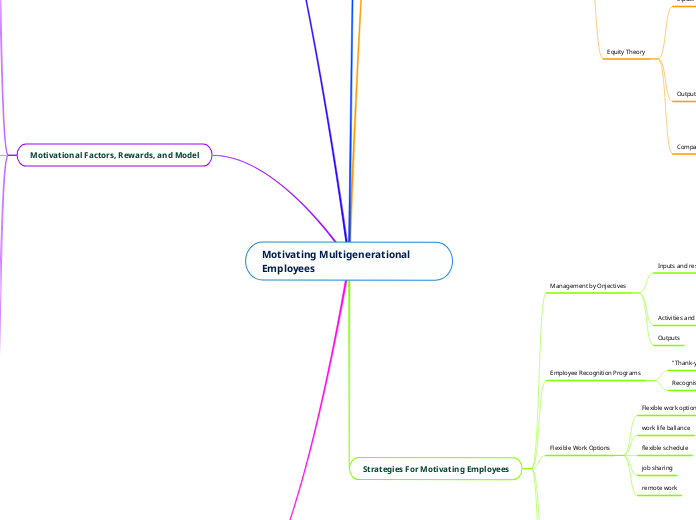Motivating Multigenerational Employees
Motivational Theories
Content Theories
Physological needs
Food, sleep, shelter, clothing
Safety needs
Free from crime, job
Social needs
Friendship, love
Self-esteem needs
recognition, respect, confident
Self-actualization
Individuals reach their fullest potential
Herzberg's Two Factor Theory
Hygiene factors
Cause of dissatisfied employees
company policies
Pay
relationships
Co-workers
Motivator factors
will make employees satisfied
Recognition
Job responsibility
Achievement
McClelland's Theory of Needs
Achievement need
based on challenging goals
Power need
Desire to control and influence other
Affiliation need
Group competition instead of competition
McGregor's Theory X and Y
X
lazy
dislike to work
dislike perform job responsibilities
Y
Employees love to work
Process Theories
Expectancy Theory
Individual have choices and will make the choice
3 element
Expectancy
will employee’s put forth the effort for a desired level of performance or performance expectancy
Instrumentality
will the employee’s performance result in rewards or performance to reward expectancy
Valance
employees will assign value to the possible outcome or reward
Financial reward
Goal Setting Theory
behavior is impacted strictly by goal setting
Harder the goal
Higher performance
Easter the goal
Lower performance
Equity Theory
Inputs
what you are putting into the job
Education
Experience
Trainning
Skills
Effort
Outputs
What are you getting out of the job
Pay
Recognition
Praise
Company car
Comparison
How do you compare you ration
Strategies For Motivating Employees
Management by Onjectives
Inputs and resources
People
Equipment
Dollar
Labor
Activities and processes
Outputs
Employee Recognition Programs
"Thank-you"
Recognise emloyees
Flexible Work Options
Flexible work options
Work from home
work life ballance
flexible schedule
job sharing
remote work
Job redesign program
Job rotation
Challange
development
gain experience
Job enlargement
changing the role within position
Job enrichment
give the employee more responsibility
Incentive Compensations Plans
Pay for performance
Piece rate pay is based on a fixed fee for th output
Profit sharing is the distribution of profit
Bonuses are usually additional
Gainsharing in an incentive plan
Skill-based pay
Solution To Motivating Employees
Motivated employee are happy
Steps
1. Management must be cognisant of the needs
2. Management will need to energise employee's behaviour using motivational theories
3. Management can sustain behaviours that offer value to employees
4. Management feedback
Introduction on Motivating Employees
4 - 5 generations working together
What Is motivating
Persistence
Intensity
Direction
To achieve the goal
Motivational Factors, Rewards, and Model
Not all employees are the same
Motivated different ways
Personality Factors
1. Personality traits and behaviors impact how employees act within the organization
2. Attitudes is a learned predisposition towards an object and directly influences our behavior
3. Values are abstract ideals that underlie how we think at work
4. According to Maslow, needs can be a psychological or physiological deficiency that can drive attitude and behaviors,
Satisfaction
Job stability
Recognition
Benefits
Organizational Contextual Factors
Organisational culture is based on the following
Internal
External
Focus
Flexibility
Stability
Values are the underlying beliefs and attitudes that define an organization
Rewards and Reinforcement can be provided in
Salary
Benefits
Rewards
Bonuses
Commissions
Team norms are the informal guidelines and code of conduct followed by employees
Interpersonal relationships with colleagues and management is important
Intrinsic and Extrinsic Rewards
Intrinsic rewards
Feel of satisfaction
Sense of recognition
Extrinsic Rewards
Pay for achieving
Completing a particular task
Motivation Model
1. Employee has an undesired need
2. Employee finds ways to be motivated
3. Employee identifies behaviour that will motivate them
4. Two types of rewards will be used
Intrisic,Extrinsic
Feedback
Reinforcement Theory
Behavior Modifications or Reinforcement Theory
Positive Reinforcement
Manager's
reward employee with raise or promotion
Employee's
Improve employee performance
Negative
Manager's
Manager avoid the interaction
Employee's
improve employee performance
Extinction
Manager's
Manager may withhold employee rewards
Employee's
Not improve employee performance
Punichment
Manager's
Managers may dock pay for driving to work late
Employee's
Not improved employee performance
